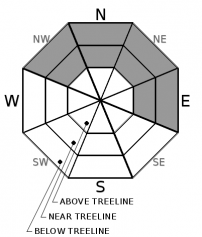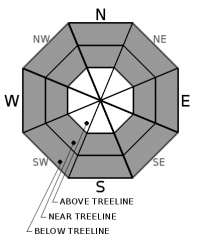| Thursday | Thursday Night | Friday | |
|---|---|---|---|
| Weather: | Partly cloudy then becoming mostly cloudy. Isolated showers in the afternoon. Snow levels below 7000 feet increasing to 7500 feet in the afternoon. Chance of precipitation is 20%. | Cloudy. Scattered showers. Snow levels 8000 feet. Chance of precipitation is 35%. | Mostly cloudy. Isolated showers in the morning. Snow levels 7000 feet. Chance of precipitation is 15%. |
| Temperatures: | 40 to 45. deg. F. | 28 to 33. deg. F. | 38 to 43. deg. F. |
| Mid Slope Winds: | Light winds. | Light winds becoming southwest around 15 mph after midnight. Gusts up to 30 mph. | Southwest around 15 mph in the morning becoming light. Gusts up to 30 mph. |
| Expected snowfall: | Little or no accumulation. | SWE = less than 0.10 inch. | 30% probability up to 1 inch. 70% probability no accumulation. | SWE = up to 0.10 inch. | No accumulation. | SWE = less than 0.10 inch. |
| Thursday | Thursday Night | Friday | |
|---|---|---|---|
| Weather: | Partly cloudy then becoming mostly cloudy. Isolated snow showers in the afternoon. Snow levels below 7000 feet increasing to 7500 feet in the afternoon. Chance of precipitation is 20%. | Cloudy. Scattered showers. Snow levels 8000 feet. Chance of precipitation is 35%. | Mostly cloudy then becoming partly cloudy. Isolated snow showers in the morning. Snow levels 7000 feet. Chance of precipitation is 15%. |
| Temperatures: | 35 to 41. deg. F. | 26 to 31. deg. F. | 35 to 41. deg. F. |
| Ridge Top Winds: | Southwest 10 to 20 mph with gusts to 30 mph. | Southwest 15 to 25 mph. Gusts up to 30 mph increasing to 45 mph after midnight. | Southwest 15 to 30 mph with gusts to 60 mph. |
| Expected snowfall: | Little or no accumulation. | SWE = less than 0.10 inch. | 70% probability up to 2 inches. 30% probability of 2 to 4 inches. | SWE = up to 0.20 inch. | Up to 1 inch. | SWE = less than 0.10 inch. |



























